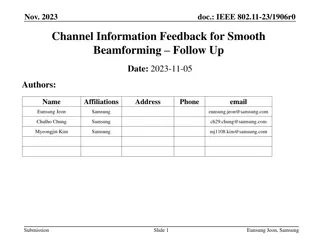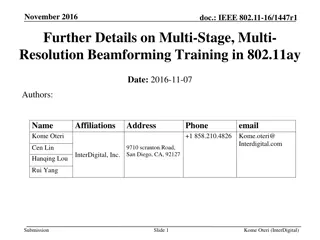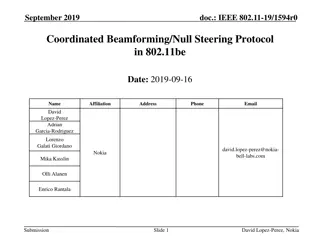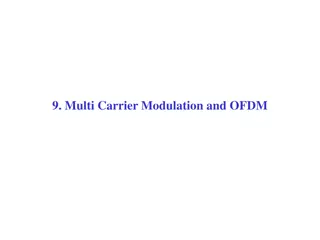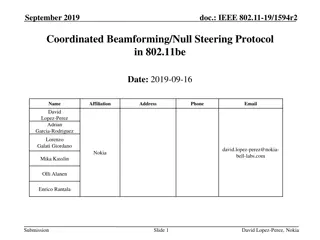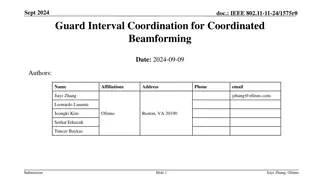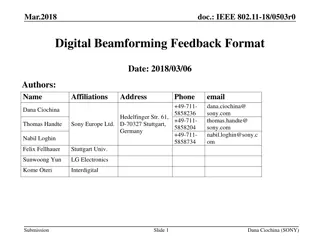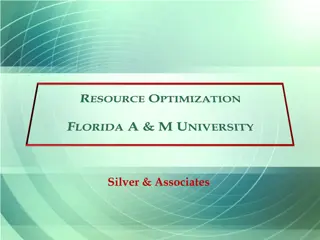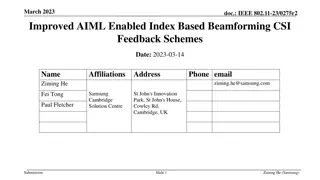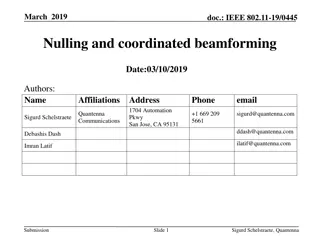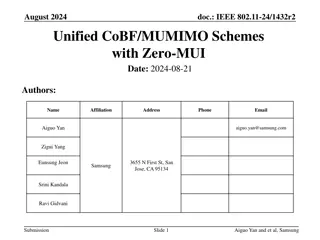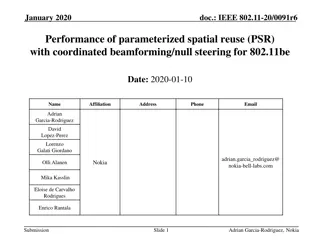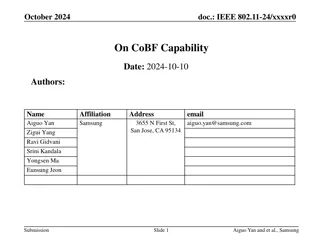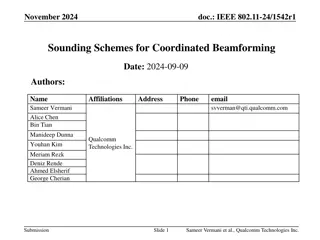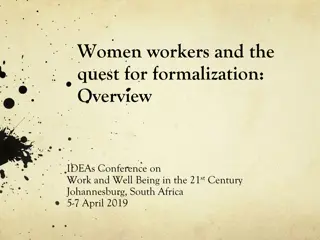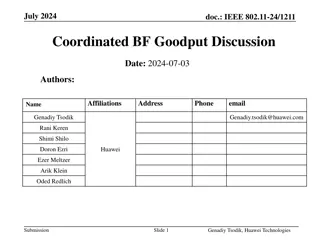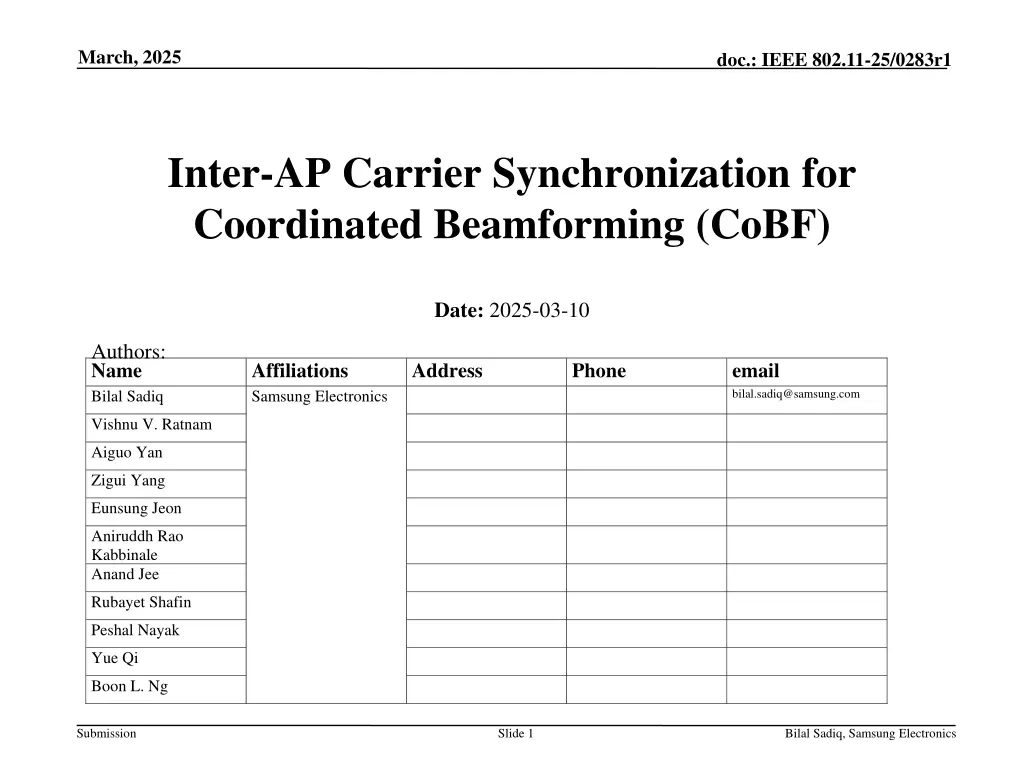
IEEE 802.11-25/0283r1 Inter-AP Carrier Synchronization for Coordinated Beamforming
Discover the requirements and solution for achieving carrier synchronization between access points in coordinated beamforming systems according to IEEE 802.11-25/0283r1. The document outlines the necessary frequency alignment criteria, proposes a practical approach involving sync reference and sync follower roles, and emphasizes the importance of defining normative behaviors for APs. Simplified protocols are suggested to facilitate seamless carrier synchronization without the need for inter-AP role negotiation.
Download Presentation

Please find below an Image/Link to download the presentation.
The content on the website is provided AS IS for your information and personal use only. It may not be sold, licensed, or shared on other websites without obtaining consent from the author. If you encounter any issues during the download, it is possible that the publisher has removed the file from their server.
You are allowed to download the files provided on this website for personal or commercial use, subject to the condition that they are used lawfully. All files are the property of their respective owners.
The content on the website is provided AS IS for your information and personal use only. It may not be sold, licensed, or shared on other websites without obtaining consent from the author.
E N D
Presentation Transcript
March, 2025 doc.: IEEE 802.11-25/0283r1 Inter-AP Carrier Synchronization for Coordinated Beamforming (CoBF) Date: 2025-03-10 Authors: Name Bilal Sadiq Affiliations Samsung Electronics Address Phone email bilal.sadiq@samsung.com Vishnu V. Ratnam Aiguo Yan Zigui Yang Eunsung Jeon Aniruddh Rao Kabbinale Anand Jee Rubayet Shafin Peshal Nayak Yue Qi Boon L. Ng Submission Slide 1 Bilal Sadiq, Samsung Electronics
March, 2025 doc.: IEEE 802.11-25/0283r1 Inter-AP carrier sync requirements 1. Carrier frequency difference between the transmission of AP1 and that of AP2 should be smaller than TBD threshold (~350Hz for 90th %-tile) 2. Carrier frequency during all sounding transmissions* and subsequent PPDU transmission of an AP should be fairly close (<<subcarrier spacing, but no additional requirements on phase noise specified) *Note: For sequential in-BSS sounding, it seems possible for an AP to post-correct channel feedback instead of pre-correcting its transmission for inter-AP CFO Submission Slide 2 Bilal Sadiq, Samsung Electronics
March, 2025 doc.: IEEE 802.11-25/0283r1 Solution 1. At any given time, designate an AP as syncreference and the other as sync follower [1] [3] 2. Each time syncfollower receives a frame from the other AP, it refines carrier sync (i.e., estimates residual CFO and applies correction to subsequent CoBF-related transmissions) 3. Do we need negotiation between APs to agree on sync roles? (This is a bad question.) What normative behaviour does 11bn need to define for an AP? What is the normative behaviour associated with Sync-Follower? If one AP is applying Sync-Follower behaviour, does it mean the other AP is Sync-Reference? (NO) This contribution: Protocols in [1] [3] can be simplified such that Both APs follow exactly the same simple behaviour to acquire and maintain carrier sync No inter-AP role negotiation is required (MAC or outside-the-Standards) Submission Slide 3 Bilal Sadiq, Samsung Electronics
March, 2025 doc.: IEEE 802.11-25/0283r1 Summary Spec needs to define only the following behaviour, followed by all APs: An AP receiving an NDPA, CoBF-trigger (or other TBD frames with inter-AP fields) from the other AP shall apply syncfollower behaviour, i.e., receiving AP shall estimate residual CFO w.r.t transmitting AP, and remove CFO to within required bound from subsequent CoBF-related transmissions AP is allowed to forget inter-AP residual CFO correction if it has not been refreshed or used for transmission for ????? TUs (TBD) Submission Slide 4 Bilal Sadiq, Samsung Electronics
March, 2025 doc.: IEEE 802.11-25/0283r1 Summary Spec needs to define only the following behaviour, followed by all APs: An AP receiving an NDPA, CoBF-trigger (or other TBD frames with inter-AP fields) from the other AP shall apply syncfollower behaviour, i.e., receiving AP shall estimate residual CFO w.r.t transmitting AP, and remove CFO to within required bound from subsequent CoBF-related transmissions AP is allowed to forget inter-AP residual CFO correction if it has not been refreshed or used for transmission for ????? TUs (TBD) Next few slides: Examples of both APs applying this behavior to acquire and maintain carrier sync Submission Slide 5 Bilal Sadiq, Samsung Electronics
March, 2025 doc.: IEEE 802.11-25/0283r1 Joint Sounding (1/2) 1. At AP2, update estimated CFO ?21 2. Then compensate AP2 s carrier for subsequent transmissions ???2??? = ???2??? + ?21 3. At AP1, update estimated CFO ?12 Note: In steady state, the updates to estimated residual CFOs at either AP remain fairly small, tracking carrier frequency drift due to phase noise. 4. Then compensate AP1 s carrier for subsequent transmissions ???1??? = ???1??? + ?12 Note: residual CFO ?12 is now expected to be very small Submission Slide 6 Bilal Sadiq, Samsung Electronics
March, 2025 doc.: IEEE 802.11-25/0283r1 Joint Sounding (2/2) Highlights Sync refinement at each inter-AP communication: Receiving AP always estimates (residual) CFO w.r.t to the transmitting AP I.e. both APs participate in refinement, follow identical behavior No need to negotiate/designate different sync roles Transmitting AP always applies latest estimated CFO correction (if available) Recall, CFO corrections are forgotten by the APs if not refreshed/used for ????? seconds. Simpler spec writing, more robust/faster convergent sync, symmetric AP behaviors Submission Slide 7 Bilal Sadiq, Samsung Electronics
March, 2025 doc.: IEEE 802.11-25/0283r1 Sequential Sounding (1/2) 1. At AP2, update estimated CFO ?21 2. Then compensate AP2 s carrier for subsequent transmissions ???2??? = ???2??? + ?21 Note: In steady state, the updates to estimated residual CFOs at either AP remain fairly small, tracking carrier frequency drift due to phase noise. 3. At AP1, update estimated CFO ?12 4. Then compensate AP1 s carrier for subsequent transmissions ???1??? = ???1??? + ?12 Note: residual CFO ?12 is now expected to be very small Submission Slide 8 Bilal Sadiq, Samsung Electronics
March, 2025 doc.: IEEE 802.11-25/0283r1 Sequential Sounding (2/2) Highlights Sync refinement at each inter-AP communication: Receiving AP always estimates (residual) CFO w.r.t to the transmitting AP I.e. both APs participate in refinement, follow identical behavior No need to negotiate/designate different sync roles Transmitting AP always applies latest estimated CFO correction (if available) Recall, CFO corrections are forgotten by the APs if not refreshed/used for ????? seconds. Simpler spec writing, more robust/faster convergent sync, symmetric AP behaviors Submission Slide 9 Bilal Sadiq, Samsung Electronics
March, 2025 doc.: IEEE 802.11-25/0283r1 Recap: Both APs can follow identical normative behavior An AP receiving an NDPA, CoBF-trigger (or other TBD frames with inter-AP fields) from the other AP as part of CoBF operation, shall estimate residual CFO w.r.t transmitting AP, and if a valid CFO estimate is available, remove estimated CFO to within required bound from subsequent CoBF-related transmissions that are required to be carrier synchronized for CoBF operation What does it mean for an AP to have valid inter-AP CFO estimate? Submission Slide 10 Bilal Sadiq, Samsung Electronics
March, 2025 doc.: IEEE 802.11-25/0283r1 Recap: Both APs can follow identical normative behavior An AP receiving an NDPA, CoBF-trigger (or other TBD frames with inter-AP fields) from the other AP as part of CoBF operation, shall estimate residual CFO w.r.t transmitting AP, and if a valid CFO estimate is available, remove estimated CFO to within required bound from subsequent CoBF-related transmissions that are required to be carrier synchronized for CoBF operation Validity duration of inter-AP CFO estimate for CoBF operation An AP shall deem an estimated inter-AP CFO as valid for compensating an upcoming CoBF-related transmission, if the CFO was estimated from a transmission that started less than ????? ??? before the start of to-be-compensated CoBF-related transmission, OR the estimated CFO was used to compensate a CoBF-related transmission less than ????? ??? before the start of to-be-corrected CoBF-related transmission. Note: An AP is not required to remember or apply the CFO correction after it has become invalid. However, AP may continue to apply the CFO correction for a longer duration, as implementation choice. Submission Slide 11 Bilal Sadiq, Samsung Electronics
March, 2025 doc.: IEEE 802.11-25/0283r1 Recap: Both APs can follow identical normative behavior An AP receiving an NDPA, CoBF-trigger (or other TBD frames with inter-AP fields) from the other AP as part of CoBF operation, shall estimate residual CFO w.r.t transmitting AP, and if a valid CFO estimate is available, remove estimated CFO to within required bound from subsequent CoBF-related transmissions that are required to be carrier synchronized for CoBF operation Validity duration of inter-AP CFO estimate for CoBF operation An AP shall deem an estimated inter-AP CFO as valid for compensating an upcoming CoBF-related transmission, if the CFO was estimated from a transmission that started less than ????? ??? before the start of to-be-compensated CoBF-related transmission, OR the estimated CFO was used to compensate a CoBF-related transmission less than ????? ??? before the start of to-be-corrected CoBF-related transmission. Note: Optionally MAC or OOB negotiations can be introduced and different sync roles can be defined for APs. But different sync roles are not required. Slide 12 Submission Bilal Sadiq, Samsung Electronics
March, 2025 doc.: IEEE 802.11-25/0283r1 References 1. 11-24/1542r5, Sounding Schemes for Coordinated Beamforming 2. 11-25/0083r0, CFO Correction for COBF 3. 11-25/0103r0, Simplified Carrier Synchronization for CoBF Transmissions 4. 11-24/2142r0, Multi-AP Sounding Analysis Submission Slide 13 Bilal Sadiq, Samsung Electronics

